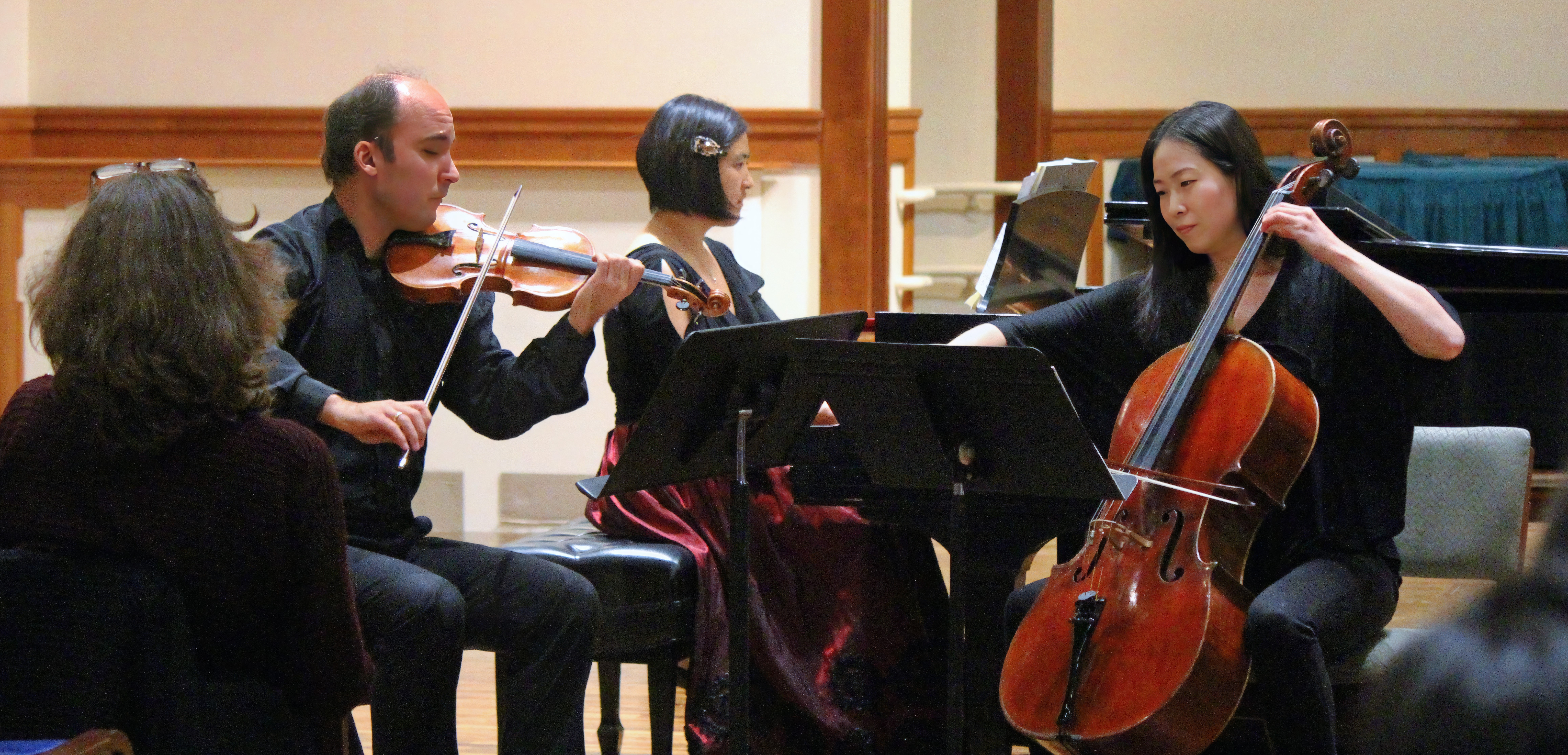Mile Twelve, A Bluegrass Concert, Saturday, January 20th at 7:00 pm
Join us for a spectacular bluegrass show by Mile Twelve, a band that pushes the limits of the genre and creates new musical possibilities. With a mix of original songs and traditional tunes, the band showcases a fresh and dynamic bluegrass sound.
Get your tickets in advance or, if not sold out, at the door.
W4RP Concert, Friday, February 9 at 7:30 pm

Prepare to be transported into a world where classical music meets innovation as W4RP takes center stage, redefining musical boundaries with their unique sound and unparalleled energy.
On Saturday, February 9th at 7:30 pm, immerse yourself in an extraordinary musical journey as Mikael Darmanie (Piano), Ju Young Lee (Cello), Rick Martinez (Percussion), and Josh Henderson (Violin) come together in a groundbreaking performance.
W4RP is not just a musical ensemble but a convergence of chamber music finesse, rock band intensity, and avant-garde artistic expression. Experience the electrifying fusion of their original compositions, dynamic interpretations of popular music, improvisation, and fresh perspectives on classical repertoire.
Get your concert tickets in advance
Educational Residency Workshop by W4RP at Concord Conservatory of Music
We’re giving our students another opportunity to stretch themselves outside of their musical comfort zones and try something new. Before the main event, W4RP extends its passion for musical innovation to the community with an Educational Residency Workshop at the Concord Conservatory of Music.
From 5:00 to 6:00 pm, string and piano students in grades 5 to 9 are invited to explore creative expression in a workshop led by W4RP members. Focusing on improvisation and the joy of spontaneous musical creation, the workshop encourages participants to experiment with different styles, techniques, and draw inspiration from real-life emotions. Register at ConcordConservatory.org to embark on this musical journey ($10 fee for non-CCM students).
The 2023-2024 Concert & Lecture Series is made possible in part by our Lead sponsor, Emerson Health.

What do Fidelity, Raytheon, and State Street have in common?
They have matching gift programs.
Won’t you please consider giving the gift of music today?
Are you a CCM friend yet?
Join us on Instagram and Facebook to be the first to learn CCM news and more! See what music videos we like, photos we post, practice tips and articles we suggest, and new music in the music world. Be sure to bookmark the CCM Blog to never miss a new post.

Growing up in Pazardjik, Bulgaria, Angel Valchinov picked up his training in classical music practically by osmosis. His mother, Margaritka, was a professional violinist who toured the world. “I learned a lot just by going to her rehearsals and her concerts,” Angel recalls.
In addition, he loved listening to Russian violinists perform classic pieces like Vivaldi’s Four Seasons and Brahms Violin Concerto on classic vinyl.
But it’s unlikely Angel would ever have made a career of playing the violin without a little help from his friends. “I got serious around 13 or 14.” Angel recalls. “By then I had several friends who also played. We were all kind of violin nerds.”
Forming Ties with Strings
It was an early lesson in the value of encouraging kids to play together and support each other. “It not only keeps kids engaged, but it also lets them know that playing an instrument, as hard as it is, can lead to an amazing experience when they play with others,” says Angel, a CCM violin instructor.
Besides, Angel added, “Students tend to have a lot more fun when they play with their friends instead of having an adult telling them what to do all the time.”
Learning to Be Part of Something Bigger
That social aspect — kids just having fun with their friends — is an often-overlooked aspect of music education. That’s why Angel makes it a priority. “As soon as they are able, I encourage kids to go and play with others,” he says.
But playing in a group isn’t just fun and games. Ensemble performances also teach kids how to  collaborate. “When you’re part of a group, you have to sacrifice your ego and try to benefit the greater good,” Angel says. “That can be another wonderfully rewarding experience because you give of yourself. And in the end you contribute to something better than you could yourself alone.”
collaborate. “When you’re part of a group, you have to sacrifice your ego and try to benefit the greater good,” Angel says. “That can be another wonderfully rewarding experience because you give of yourself. And in the end you contribute to something better than you could yourself alone.”
Finding the Proper Balance
One of the greatest challenges for music teachers is to get kids to do the hard, individual work necessary for success without succumbing to loneliness. In Angel’s case, that loneliness was particularly severe because it was compounded by homesickness. He was just 16 when his mother’s connections helped him land a full scholarship at California’s Idyllwild Arts Academy. “It was a boarding high school and I came here to study by myself,” Angel says. “I absolutely hated it for the first few months.”
In the end, Angel says, the Idyllwild experience “turned out to be one of the best things that could have happened to me because it made me quite strong.” But he also recognizes that not every student will persevere through those intense periods of isolation.
That’s why Angel is so supportive of ensemble performance opportunities like CCM’s West Side Strings Program. It can be just the antidote a kid needs when their enthusiasm wanes. “Playing in a group makes them more eager and responsive when they go back to their individual lessons,” Angel says, “because they realize that those individual lessons are a pathway that can allow them to experience so much more.”
Also, younger kids who may lack self-confidence in their ability as solo performers can relax and enjoy the comfort and support of playing in a group.
A Whole Greater Than the Sum
None of this suggests that solo performances have no value other than as a means to an end. Angel’s great aunt Nadka Karadjova — “She was probably the best-known folk singer in Bulgaria,” he says — is proof enough of that. She honed her voice into a hauntingly beautiful solo instrument. (Give Nadka a listen — there are many examples of her work archived on YouTube.) Rather, it’s to show kids that playing in a group can give them a much deeper and richer appreciation of the power of music.
And again: It’s fun. It also inspires kids to communicate with each other. “That’s the goal,” Angel says. “They don’t have to say a word to each other when they’re collaborating musically — but they are still connecting.”